Nine Structural Domains of Competency Education, Part II
CompetencyWorks Blog
 This is the ninth blog in a series leading up to the National Summit on K-12 Competency-Based Education. We are focusing on four key areas: equity, quality, meeting students where they are, and policy. (Learn more about the Summit here.) We released a series of draft papers in early June to begin addressing these issues. This article is adapted from In Search of Efficacy: Defining the Elements of Quality in a Competency-Based Education System. It is important to remember that all of these ideas can be further developed, revised, or combined – the papers are only a starting point for introducing these key issues and driving discussions at the Summit. We would love to hear your comments on which ideas are strong, which are wrong, and how we might be able to advance the field.
This is the ninth blog in a series leading up to the National Summit on K-12 Competency-Based Education. We are focusing on four key areas: equity, quality, meeting students where they are, and policy. (Learn more about the Summit here.) We released a series of draft papers in early June to begin addressing these issues. This article is adapted from In Search of Efficacy: Defining the Elements of Quality in a Competency-Based Education System. It is important to remember that all of these ideas can be further developed, revised, or combined – the papers are only a starting point for introducing these key issues and driving discussions at the Summit. We would love to hear your comments on which ideas are strong, which are wrong, and how we might be able to advance the field.
In this article, we describe the nine domains of a competency-based structure (remember: this is a draft and we want ideas about what is missing and what shouldn’t belong) and key questions that could open the door to discussions about quality. In the paper, you can also find exemplars and ‘look-fors’ – and we want to collect the best examples we can find over the next month.
WHAT IS THE WORK?
Structural Domain 1. Mission-Driven Districts and Schools Dedicated to Preparing Each and Every Student for Life, College, and Careers
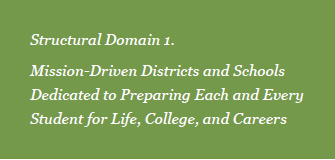
Description of Structures – Beliefs, Policies, Operational Processes
One of the most powerful leverage points that states, districts, and schools have to transform their schools is the opportunity to expand expectation of student success. Success in college and careers takes much more than comprehension of the core academic subjects. Students need to become self-directed, lifelong learners with critical thinking and problem-solving skills to address challenges and take advantage of opportunities. They will also need skills such as communication, collaboration, and cultural competence to help them work in ever-changing, diverse workplaces. In order for students to develop these skills, they need to be actively learning, with opportunities to apply their skills in new contexts.
Key Questions to Ask in Self-Assessment or District/School Reviews
- What is the definition of school success or graduation outcomes that shapes the school mission and guiding principles?
- What role have the community, parents, and students had in shaping the vision and mission?
- How is the the mission actively referenced as a guide to make key decisions?
- In what way is the district and school designed to help students develop all the skills identified in their graduate profiles or graduation expectations, including lifelong learning skills, higher order skills, and academic skills?
- How will the community know if the district and school are achieving outcome goals for students? How will they know if the outcomes are equitable?
- How is the use of resources (facilities, money, staffing, and time) aligned with the mission and learning goals?
WHAT IS THE STRATEGY OR THEORY OF CHANGE?
Structural Domain 2. Students Advance Based on Demonstration of Mastery
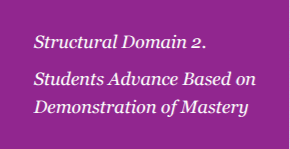 Description of Structures – Beliefs, Policies, Operational Processes
Description of Structures – Beliefs, Policies, Operational Processes
When students advance upon mastery, not time, educators can direct their efforts to where students need the most help and make sure they learn the skills they will need in more advanced courses. This is one of the ways that competency-based education will contribute to greater equity. The features of advancing upon mastery are based upon research on motivation, engagement, and learning. Students are more engaged and motivated when grading is seen as feedback that helps them show what they know and focuses on what they need to work on rather than judgment. Students may spend more time working in those areas that are more difficult for them. They may even advance beyond grade level in some domains, while taking more time in those that are more challenging.
There are several features of the “move on when ready” policy to advance upon mastery, all of which need to be taken into consideration:
- Schools are designed to meet students where they are. There are multiple strategies to do this depending on where students are in their learning, the presence and size of their skills gap, the needs of other students in the class, the domain, and the knowledge-based and instructional skills of the teacher. Districts and schools have to organize resources and schedules to have organizational agility to respond to the needs and progress of students.
- When students have gaps in skills, the teacher takes responsibility for working with the student to address and build fluency in those skills. The expectation is that the skill gap will be addressed.
- Students should be able to work on different learning targets and units within a class or have access to instruction at their performance level. This includes offering classes above or below the grades of a school. Thus, seventh graders who are ready should be able to take ninth grade math.
- The term mastery suggests that students should be proficient in the learning targets and be able to apply them in new contexts. This means that students need opportunity for: 1) projects and inquiry-based learning that requires them to select content and skills to apply to the problem; 2) performance-tasks or performance-based assessment; and 3) coaching in higher order skills, not just academic skills and content.
- Districts and schools need to put in place the processes and structures to ensure reliability of assessments.
Beliefs, policies, and processes organized around student advancement based on demonstration of mastery include: multiple opportunities to demonstrate learning, targeted and timely instruction, coaching that supports students as they strive for the next level of mastery, and transparent feedback and grading practices that inform on pace and progress in reaching mastery. Districts and schools need to ensure that evidence-gathering against each well-designed learning outcome is valid and reliable, as this influences the degree to which students have mastered the content/skill before advancing and ensures that monitoring structures are designed for providing high quality education.
Key Questions to Ask in Self-Assessment or School Reviews
- What processes are in place to ensure every student is reaching mastery and that students above grade level have opportunities to advance and demonstrate mastery at higher levels even beyond school level and into higher education?
- What is in place to make sure everyone reaches graduation-ready competencies?
- What policies and processes are in place to ensure that students have demonstrated mastery as they advance?
- What processes are in place to ensure consistency and fairness, and that evidence for determining mastery is high quality?
- How is student learning and growth monitored to ensure progress?
- What policies and processes are in place to guard against implicit bias?
- What systems are in place to help students develop the metacognition and reflection necessary to understand what it takes to learn a given skill or body of knowledge (in essence, learning how to learn)?
Structural Domain 3. Continuum of Learning Objectives, Student Performance, Growth, and Progress are Transparent
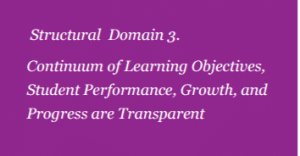 Description of Structures – Beliefs, Policies, Operational Processes
Description of Structures – Beliefs, Policies, Operational Processes
Transparency of district-wide or school-wide learning objectives and student progress toward those objectives is one of the high leverage aspects of competency-based education. Although transparency does not automatically result in greater student agency, it is required for fostering greater ownership by students over their education, and providing opportunity for choice in how they learn and how they demonstrate their learning. In a quality competency-based structure, students receive feedback (scores or grades) that helps them understand how they are progressing toward the learning objectives. Teachers collaborate frequently and with intentionality about what they want students to know and be able to do. Working together, they improve instruction and assessment literacy, and build deeper understanding of learning progressions. They also monitor the outcomes and experiences of subgroups of students so they can share responsibility for eliminating disproportionality in outcomes. In addition, family and community support can be marshaled around attainment of learning targets.
Key Questions to Ask in Self-Assessment or School Reviews
- What has been taken into consideration in creating the learning objectives (competencies and standards)?
- How comprehensively and effectively do assessments measure students’ mastery of learning objectives?
- How do the assessment strategies (including portfolios, projects, and capstones for deeper learning) reflect the learning objectives?
- In what ways are students empowered to take responsibility for their learning, including skill building? In what way do they have opportunity for co-design of how they learn or how they demonstrate learning, choice, and voice?
- How are transparent learning objectives used to improve teaching and drive personalized, job-embedded professional development?
- In what ways are students’ academic performances tracked systematically to identify those who may be lagging or struggling? How is this tracking being used to ensure that appropriate supports are put into place and that the supports are effective?
- How do we re-engage and support students who have experienced failure within the traditional system r? What strategies are in place (positive youth development, SEL, mindsets, CRE, community school models, other) to re-engage learners and bridge gaps in learning so that students feel they belong in school, value school, and are successful in their academic work?
Structural Domain 4. District and School Organization Empowers Students and Educators
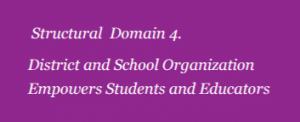 Description of Structures – Beliefs, Policies, Operational Processes
Description of Structures – Beliefs, Policies, Operational Processes
Competency-based education makes the desired learning clear to the student, enabling the student, family, and community to know, in advance, what is expected and to apply the effort necessary to demonstrate the expected learning and habits. In other words, competency-based education is designed to empower students and educators. Students are supported in building sufficient skills and a framework of knowledge to take responsibility for their education and become lifelong learners. Educators are empowered to collaborate in responding to the changing needs of students so that all students are making progress.
Non-negotiables:
- Students and educators are treated with respect and supported in developing agency and ownership of their learning.
- Educators require personalized professional learning and latitude to use their professional judgment.
Key Questions to Ask in Self-Assessment or School Reviews
- What policies and structures are in place to support students in building lifelong learning skills and taking ownership of their learning?
- How is responsibility shared within the district and school for student success?
- What information is available to educators to support decision-making regarding instruction?
- What structures are in place to enable students and staff to participate in continuous improvement?
- What professional learning structures (job-embedded coaching, micro-credentialing, peer feedback, studio cycles, educator competencies, etc.) are in place to empower teachers and administrators to grow in student-centered practices through their own learner-centric experiences?
Structural Domain 5. Schools have Autonomy and Flexibility to Provide Timely, Differentiated Support to Students
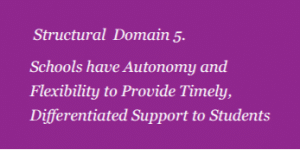 Description of Structures – Beliefs, Policies, Operational Processes
Description of Structures – Beliefs, Policies, Operational Processes
Policies, operations, and deployment of resources designed to be responsive to student learning need to provide timely, differentiated instructional and other necessary supports. Every student struggles at one point or another. To keep engagement high and quickly address misconceptions before they become rooted in a student’s understanding, competency-based schools provide flex time during the day for students to receive additional instructional support. When students don’t complete a course within the semester, they continue to focus on the specific skills they need to develop as they move to the next semester or through additional time after school or in the summer. What they do not need to do is retake an entire course. Districts and schools are organized to be responsive to student progress with flexibility to provide the necessary support, including creating additional time for learning.
Non-negotiables:
- Schools need to have autonomy and a high level of control over their budgets and hiring to increase agility to respond to student needs, interests, changing demographics, and opportunities.
- Scheduling must be designed to offer frequent support for students who are struggling and opportunities for teachers to work within professional learning communities.
- Districts and schools need autonomy to define graduation competencies and the steps toward it such as credits, performance levels, and phases.
Key Questions to Ask in Self-Assessment or School Reviews
- What are the capacities, structures, and systems that have been put into place to respond to students’ needs and progress (academic and lifelong learning skills)? How effective are they, and how do they know?
- What are the pedagogical (or instructional) approaches used to meet students where they are?
- How does the master schedule provide students with just-in-time instruction and support?
- What structures are in place to validate anytime/anywhere learning in partnership with experiences or entities beyond the walls of the school?
HOW IS EFFECTIVENESS OPTIMIZED?
Structural Domain 6. Internal Accountability Ensures Consistency and Reliability
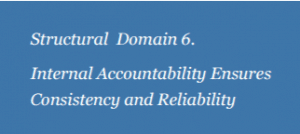 Description of Structures – Beliefs, Policies, Operational Processes
Description of Structures – Beliefs, Policies, Operational Processes
A quality CBE system relies upon the consistency and reliability of the evidence used to inform, develop, and ultimately demonstrate learner competencies. In competency education, educators take responsibility for ensuring all students are learning, progressing, and have a plan to reach graduation and college/career readiness. For example, a policy to eliminate the option to pass students on with Cs and Ds and replace it with the concept of “Not Yet” supports internal accountability necessary to develop quality within a competency-based structure. In turn, this policy requires processes that ensure consistency (in expectations), reliability (in assessing student learning and in growth rates), and continuous improvement (for students, adults, and the entire organizational performance). Accompanying these policies and processes is the belief that all students can demonstrate proficiency and achieve high expectations.
Elements of this domain within a quality competency-based structures should include:
- Aligning learning objectives, instruction, and assessment: Structures and processes are in place to ensure that the instruction and assessments are fully aligned with the learning objectives and offer rich and frequent opportunities for students to perform at the highest possible depth of knowledge.
- Calibrating proficiency: Formal processes are in place to ensure that within a school, districts are reliably determining proficiency and there are efforts to calibrate across schools and with other districts.
- Educators monitor growth and students pacing toward graduation and a personal learning trajectory with steps to provide additional instruction support and interventions as needed: Educators work closely together to monitor student growth supported by formal structures such as professional learning communities, information systems, and access to specialized expertise. Data on student learning provides information on three types of continuous improvement:
- 1) monitoring student progress includes tracking growth on a trajectory based on each student’s performance levels and progress on a personalized plan toward graduation, pace (on or above grade level), and depth of knowledge;
- 2) interventions are monitored for effectiveness; and
- 3) student pace and growth rates drive continuous improvement to identify areas where there may be implicit bias or a need for professional learning, more effective deployment of resources, and redesign of organizational structure, policies, or processes.
- Implementing equity strategies and eliminating disproportionality in outcome: Processes and strategies are in place to monitor and respond so that students who have been historically underserved are receiving adequate evidence-based support, are demonstrating reasonable growth (1.0 performance levels or more per year), and are on track in their plans to reach graduation.
Key Questions to Ask in Self-Assessment or School Reviews
- What processes and structures are in place to ensure that superintendents and principals are confident that the instruction and assessments are fully aligned with the learning objectives and offer rich and frequent opportunities for students to perform at the highest possible depth of knowledge?
- In what ways is the development of lifelong learning skills included in tracking student progress and proficiency? How are students involved in monitoring progress, and is the data of this progress being used by students to set personalized goals to help them develop the ability to drive their own learning?
- What systems and structures are in place to ensure that all students are held to the same rigorous expectations, including historically/previously underserved students?
- What systems and structures are in place to ensure that all students are expected to and are given opportunities to demonstrate the ability to apply learning to challenging new contexts?
- What systems, policies, and structures are in place to ensure that students are not prevented from advancing at a pace that is commensurate with their growth potential?
Structural Domain 7. Continuous Improvement is Driven by Metrics on Pace, Progress, and Growth
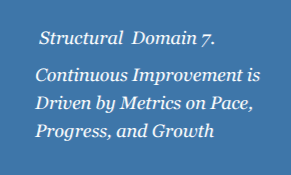 Description of Structures – Beliefs, Policies, Operational Processes
Description of Structures – Beliefs, Policies, Operational Processes
Continuous improvement is a critical element of competency-based education. When districts and schools take responsibility for ensuring every student is successful in their learning, they will need to be engaged in constant efforts to respond to students (in the short run) and improve school performance (in the long run).
Information management systems need to be designed to allow district and school leadership to monitor student progress, identify when teachers need additional support or have strengths that can be further utilized, and monitor effectiveness of processes. This requires that information management systems are built to follow a student over the K-12 continuum rather than adhere to a course-by-course basis, thereby allowing growth and pace to be monitored and measured more incrementally. This system should allow for monitoring student progress over the course of a year, not just measured in the typical nine month school year. Data dashboards, if used, can provide insights on level of proficiency, progress, individual student growth, and depth of knowledge.
Key Questions to Ask in Self-Assessment or School Reviews
- In what ways do students participate in the continuous improvement process?
- What are examples of school improvement or capacity building that have been put in place based on continuous improvement processes, and what is the result?
- How do management reports help leaders and educators monitor for potential disproportionate growth, outcomes, or marginalization?
Structural Domain 8. Teachers are Supported in Evidence-Based Professional Learning
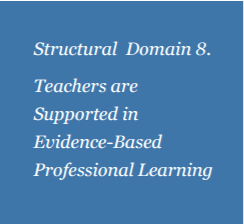 Description of Structures – Beliefs, Policies, Operational Processes
Description of Structures – Beliefs, Policies, Operational Processes
Just like their students, teachers are supported in their own learning through transparent measures of mastery, ongoing feedback, and access to evidence-based, professional learning that is responsive to their areas of growth. They have access to data that provides helpful feedback on their strengths and opportunities for growth. They are familiar with the learning sciences and apply it to their learning as we all instructional design and support for students.
Effective competency-based structures have policies, processes, and beliefs that support this structural domain. Non-negotiables include:
- A culture of trust, respect, and safety for educators.
- Dedicated time for teachers to engage in professional learning communities, collaboration, and planning.
- Structures for instructional leadership and/or coaches who provide support to teachers based on personalized professional learning.
- District and school leaders who use distributed leadership strategies that engage educators in decision-making.
Key Questions to Ask in Self-Assessment or School Reviews
- What structures and processes are in place to support teachers in inquiry-based professional learning?
- How do human resource policies reflect the mission, guiding principles, and pedagogical philosophy?
HOW IS THE ORGANIZATION OF THE DISTRICT AND SCHOOL DESIGNED TO SUPPORT THIS WORK?
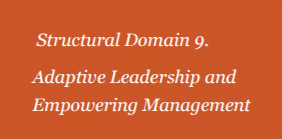 Structural Domain 9. Adaptive Leadership and Empowering Management
Structural Domain 9. Adaptive Leadership and Empowering Management
Description of Structures – Beliefs, Policies, Operational Processes
Adaptive or distributed management strategies are deployed to create an empowering learning organization. Leadership sets the tone regarding seeing mistakes as an opportunity to learn rather than one for blaming. Structures and protocols are used to support inclusive decision-making. One of the principal’s most important leadership functions is to support PLCs, making sure they have the time to meet and are staying true to the norms that allow them to be a source of collaborative, professional development.
Key Questions to Ask in Self-Assessment or School Reviews
- What type of management strategies are used and how is that reflected in daily operations?
- How are leaders supported in developing adaptive leadership strategies?
- What structures and protocols are used in meetings and to support decision-making?
- In what capacity are students, educators and community members involved in decision-making?
- How is decision-making distributed throughout the organization? How far is the “distance” between those who decide and those who are affected?
Follow this blog series:
Equity
- Post #1 – CompetencyWorks Releases New Reports on Key Issues in Competency Education
- Post #2 – Introducing an Equity Framework for Competency Education
- Post #3 – Potential Pitfalls for Ensuring Equity in Competency-Based Systems
- Post #4 – Building a Comprehensive Set of Equity Strategies
- Post #5 – Charting the Course for Equity in Competency Education
Quality
- Post #6 – Three Driving Questions for Developing High-Quality Competency-Based Systems
- Post #7 – Exploring a Four-Part Quality Framework for Competency Education
- Post #8 – Nine Structural Domains of Competency Education, Part I
Learn more:
- Learn about the National Summit on K-12 Competency-Based Education, and share what you’re learning using #CBESummit17.
- For more resources and recommended reading, visit CompetencyWorks, the CompetencyWorks wiki.
- Follow CompetencyWorks and iNACOL on Twitter: @CompetencyWorks, @nacol.
- National Summit on K-12 Competency-Based Education Recommended Reading